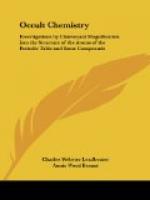CADMIUM (Plate IX, 3).
[Illustration]
Cadmium follows very closely on the lines of zinc; the pillars of the zinc spike are reproduced in the rings of the cadmium funnel; the globes are also the globes of cadmium; so neither of these needs attention. We have only to consider the three ten-atomed ovoids, which are substituted for the one ten-atomed triangle of zinc, and the central cross. The ovoids become spheres (Cd a, b), the contained bodies revolving within them, a whirling on a diameter of the sphere, cutting it in halves, as it were, and b whirling round it at right angles; the cross also becomes a sphere (Cd c), but the cruciform type is maintained within it by the relative positions of the contained spheres in their revolution. The subsequent stages are shown in the diagram.
SULPHUR (Plate XI, 1).
Sulphur has nothing new, but shows only the funnels already figured in magnesium, with the substitution of a second septet for the triplet, as in zinc.
SELENIUM (Plate X, 2).
[Illustration]
The funnel of selenium is a re-arrangement of the twelve-atomed ovoids of magnesium and the ten-atomed ovoids of cadmium. The funnels, on disintegrating, set free twelve groups, each containing nine spheres. On the meta level the ten-atomed bodies are set free, and the twelve-atomed divide into duads and decads, thus yielding seventy-two decads and thirty-six duads; the duads, however, at once recombine into hexads, thus giving only twelve meta elements, or eighty-four in all from the funnels. The central globe holds together on the proto level, but yields five meta elements. The star also at first remains a unit on the proto level, and then shoots off into seven bodies, the centre keeping together, and the six points becoming spheres, within which the two cones, base to base, whirl in the centre, and the globes circle round them. On the meta level all the thirty bodies contained in the star separate from each other, and go on their independent ways.
Selenium offers a beautiful example of the combination of simple elements into a most exquisite whole.
TELLURIUM (Plate X, 3).
Tellurium very closely resembles cadmium, and they are, therefore placed on the same diagram. The pillars are the same as in chlorine and its congeners, with a duad added at the base. The ten-atomed ovoid is the same as in cadmium and follows the same course in breaking up. It would be interesting to know why this duad remains as a duad in selenium and breaks up into a septad and triad in the other members of the group. It may be due to the greater pressure to which it is subjected in selenium, or there may be some other reason. The cross in tellurium is identical with that in cadmium, except that the centre is seven-atomed instead of four-atomed.
* * * * *




